GMC ENVOY DENALI 2007 Owners Manual
Manufacturer: GMC, Model Year: 2007, Model line: ENVOY DENALI, Model: GMC ENVOY DENALI 2007Pages: 562, PDF Size: 2.87 MB
Page 431 of 562
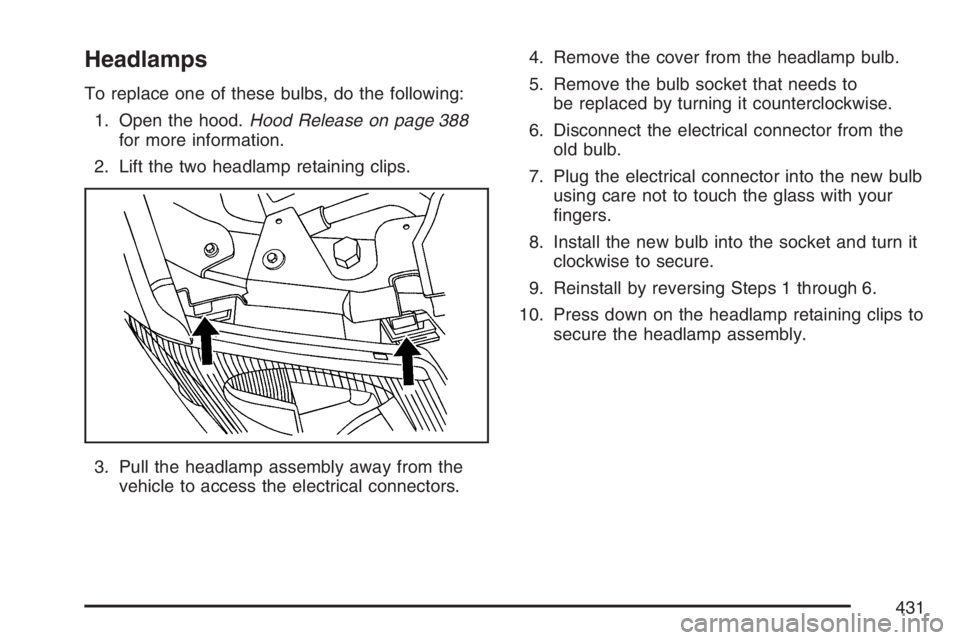
Headlamps
To replace one of these bulbs, do the following:
1. Open the hood.Hood Release on page 388
for more information.
2. Lift the two headlamp retaining clips.
3. Pull the headlamp assembly away from the
vehicle to access the electrical connectors.4. Remove the cover from the headlamp bulb.
5. Remove the bulb socket that needs to
be replaced by turning it counterclockwise.
6. Disconnect the electrical connector from the
old bulb.
7. Plug the electrical connector into the new bulb
using care not to touch the glass with your
�ngers.
8. Install the new bulb into the socket and turn it
clockwise to secure.
9. Reinstall by reversing Steps 1 through 6.
10. Press down on the headlamp retaining clips to
secure the headlamp assembly.
431
Page 432 of 562
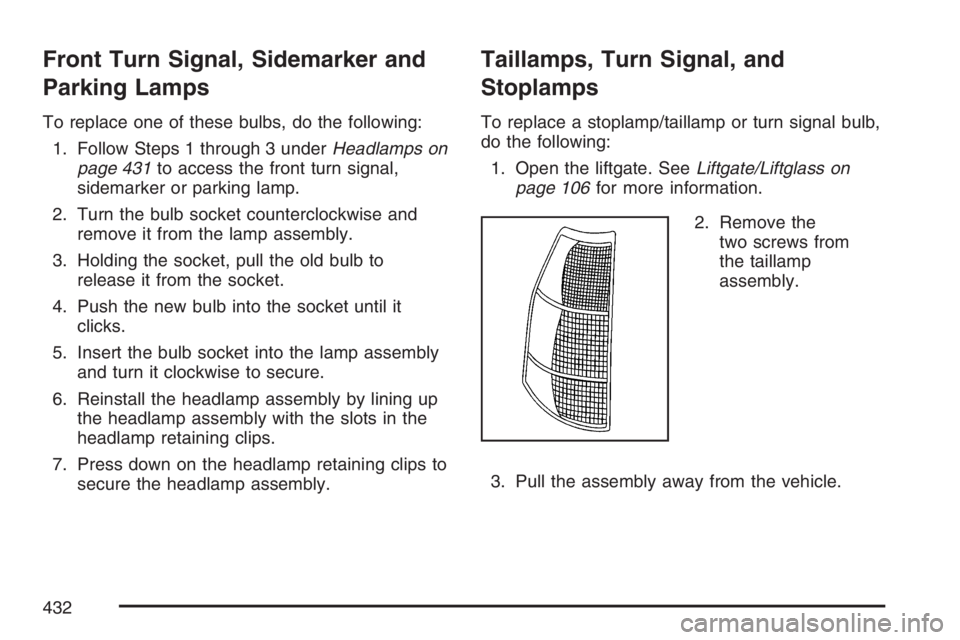
Front Turn Signal, Sidemarker and
Parking Lamps
To replace one of these bulbs, do the following:
1. Follow Steps 1 through 3 underHeadlamps on
page 431to access the front turn signal,
sidemarker or parking lamp.
2. Turn the bulb socket counterclockwise and
remove it from the lamp assembly.
3. Holding the socket, pull the old bulb to
release it from the socket.
4. Push the new bulb into the socket until it
clicks.
5. Insert the bulb socket into the lamp assembly
and turn it clockwise to secure.
6. Reinstall the headlamp assembly by lining up
the headlamp assembly with the slots in the
headlamp retaining clips.
7. Press down on the headlamp retaining clips to
secure the headlamp assembly.
Taillamps, Turn Signal, and
Stoplamps
To replace a stoplamp/taillamp or turn signal bulb,
do the following:
1. Open the liftgate. SeeLiftgate/Liftglass on
page 106for more information.
2. Remove the
two screws from
the taillamp
assembly.
3. Pull the assembly away from the vehicle.
432
Page 433 of 562
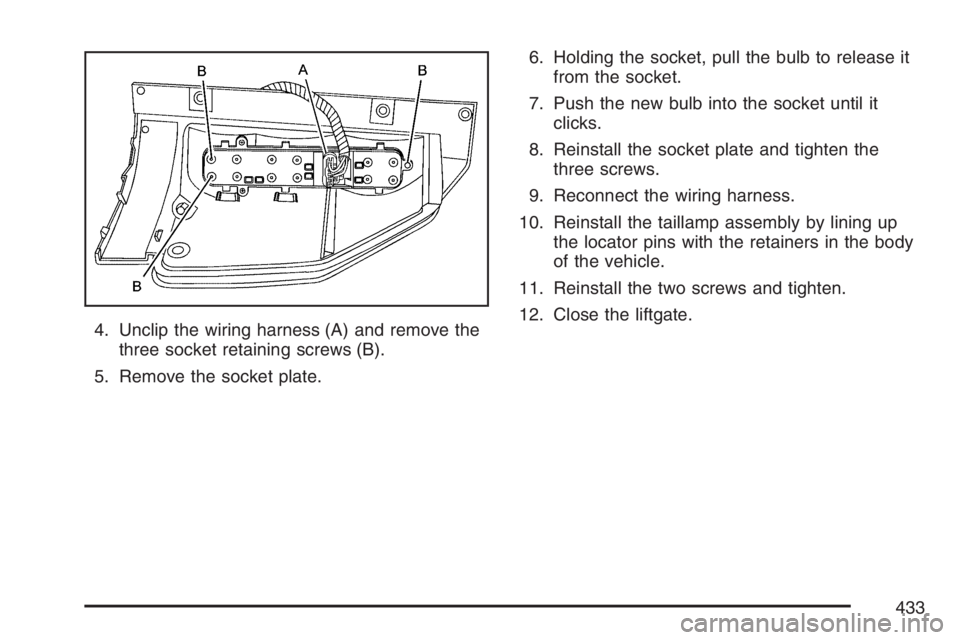
4. Unclip the wiring harness (A) and remove the
three socket retaining screws (B).
5. Remove the socket plate.6. Holding the socket, pull the bulb to release it
from the socket.
7. Push the new bulb into the socket until it
clicks.
8. Reinstall the socket plate and tighten the
three screws.
9. Reconnect the wiring harness.
10. Reinstall the taillamp assembly by lining up
the locator pins with the retainers in the body
of the vehicle.
11. Reinstall the two screws and tighten.
12. Close the liftgate.
433
Page 434 of 562
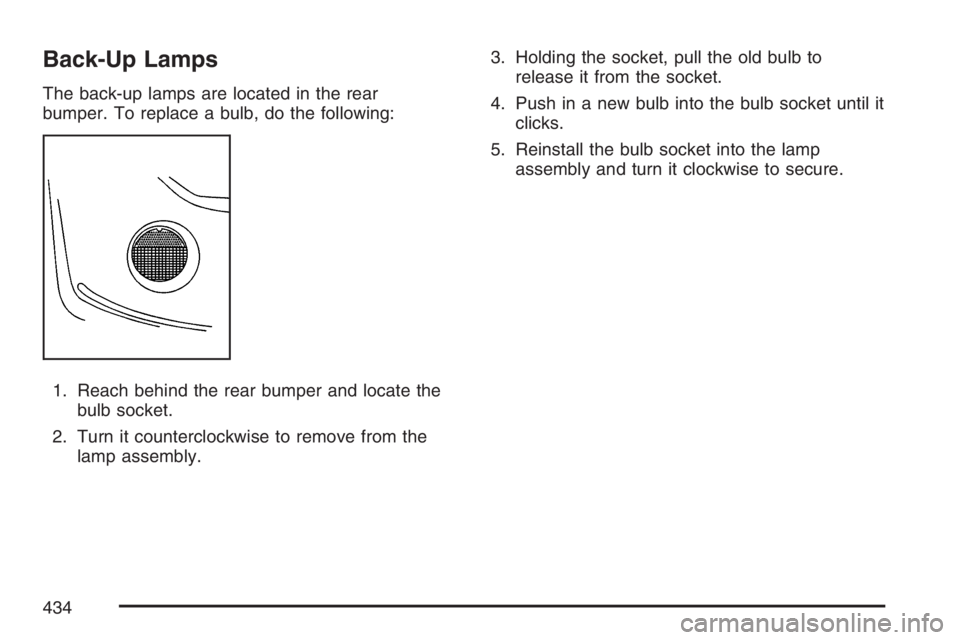
Back-Up Lamps
The back-up lamps are located in the rear
bumper. To replace a bulb, do the following:
1. Reach behind the rear bumper and locate the
bulb socket.
2. Turn it counterclockwise to remove from the
lamp assembly.3. Holding the socket, pull the old bulb to
release it from the socket.
4. Push in a new bulb into the bulb socket until it
clicks.
5. Reinstall the bulb socket into the lamp
assembly and turn it clockwise to secure.
434
Page 435 of 562
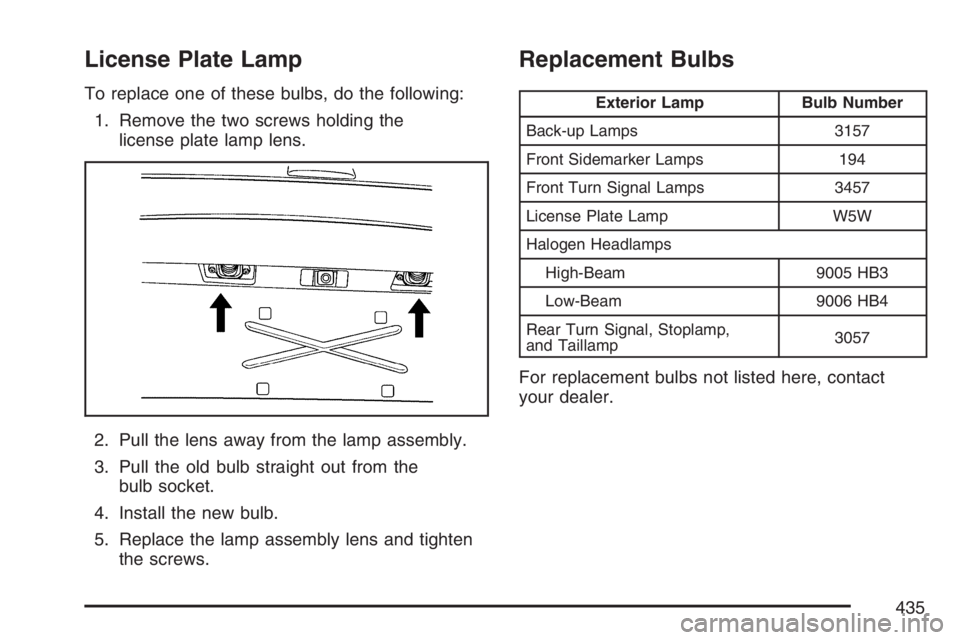
License Plate Lamp
To replace one of these bulbs, do the following:
1. Remove the two screws holding the
license plate lamp lens.
2. Pull the lens away from the lamp assembly.
3. Pull the old bulb straight out from the
bulb socket.
4. Install the new bulb.
5. Replace the lamp assembly lens and tighten
the screws.
Replacement Bulbs
Exterior Lamp Bulb Number
Back-up Lamps 3157
Front Sidemarker Lamps 194
Front Turn Signal Lamps 3457
License Plate Lamp W5W
Halogen Headlamps
High-Beam 9005 HB3
Low-Beam 9006 HB4
Rear Turn Signal, Stoplamp,
and Taillamp3057
For replacement bulbs not listed here, contact
your dealer.
435
Page 436 of 562
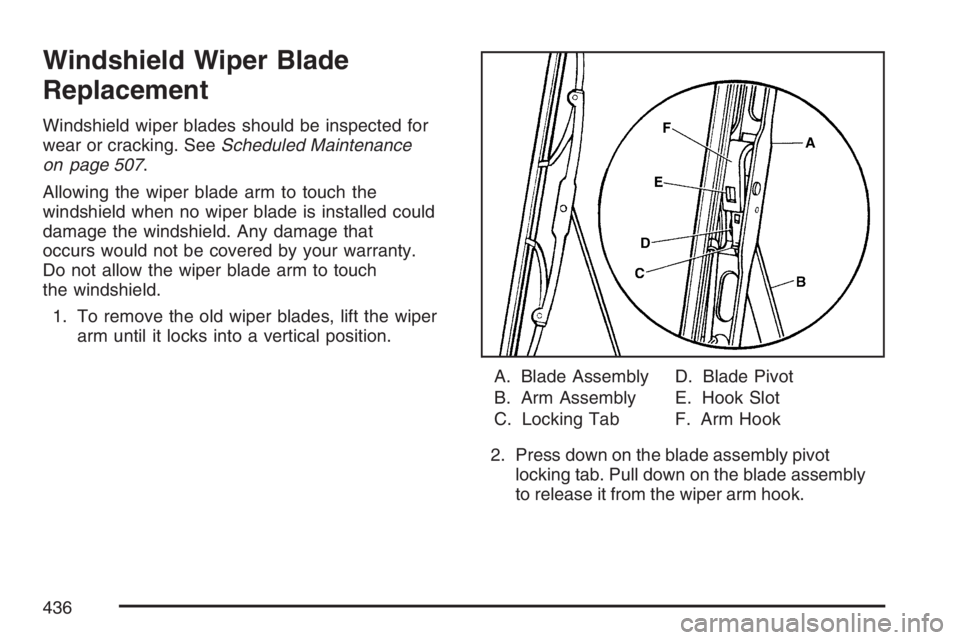
Windshield Wiper Blade
Replacement
Windshield wiper blades should be inspected for
wear or cracking. SeeScheduled Maintenance
on page 507.
Allowing the wiper blade arm to touch the
windshield when no wiper blade is installed could
damage the windshield. Any damage that
occurs would not be covered by your warranty.
Do not allow the wiper blade arm to touch
the windshield.
1. To remove the old wiper blades, lift the wiper
arm until it locks into a vertical position.
A. Blade Assembly
B. Arm Assembly
C. Locking TabD. Blade Pivot
E. Hook Slot
F. Arm Hook
2. Press down on the blade assembly pivot
locking tab. Pull down on the blade assembly
to release it from the wiper arm hook.
436
Page 437 of 562
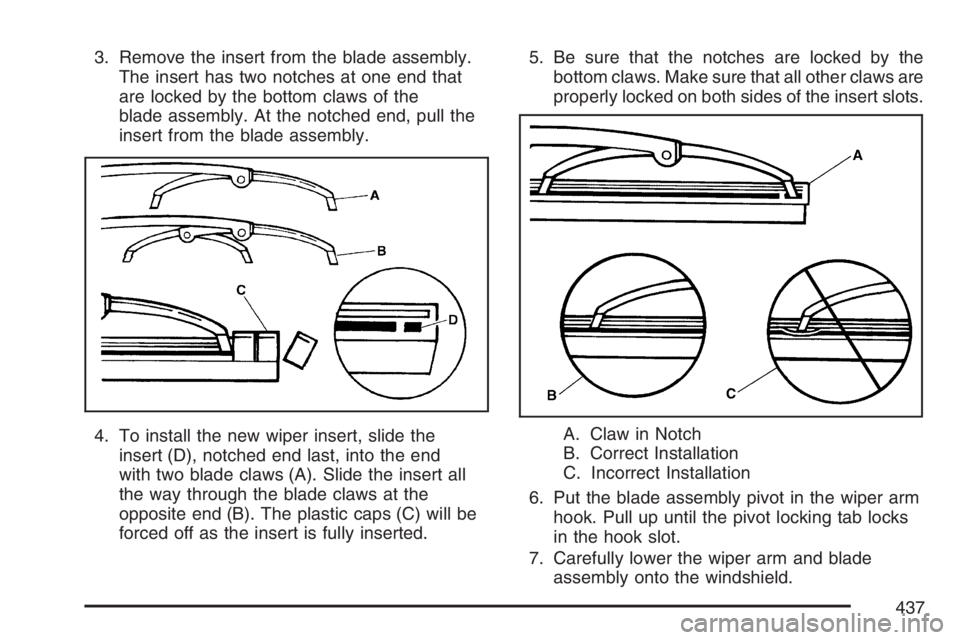
3. Remove the insert from the blade assembly.
The insert has two notches at one end that
are locked by the bottom claws of the
blade assembly. At the notched end, pull the
insert from the blade assembly.
4. To install the new wiper insert, slide the
insert (D), notched end last, into the end
with two blade claws (A). Slide the insert all
the way through the blade claws at the
opposite end (B). The plastic caps (C) will be
forced off as the insert is fully inserted.5. Be sure that the notches are locked by the
bottom claws. Make sure that all other claws are
properly locked on both sides of the insert slots.
A. Claw in Notch
B. Correct Installation
C. Incorrect Installation
6. Put the blade assembly pivot in the wiper arm
hook. Pull up until the pivot locking tab locks
in the hook slot.
7. Carefully lower the wiper arm and blade
assembly onto the windshield.
437
Page 438 of 562
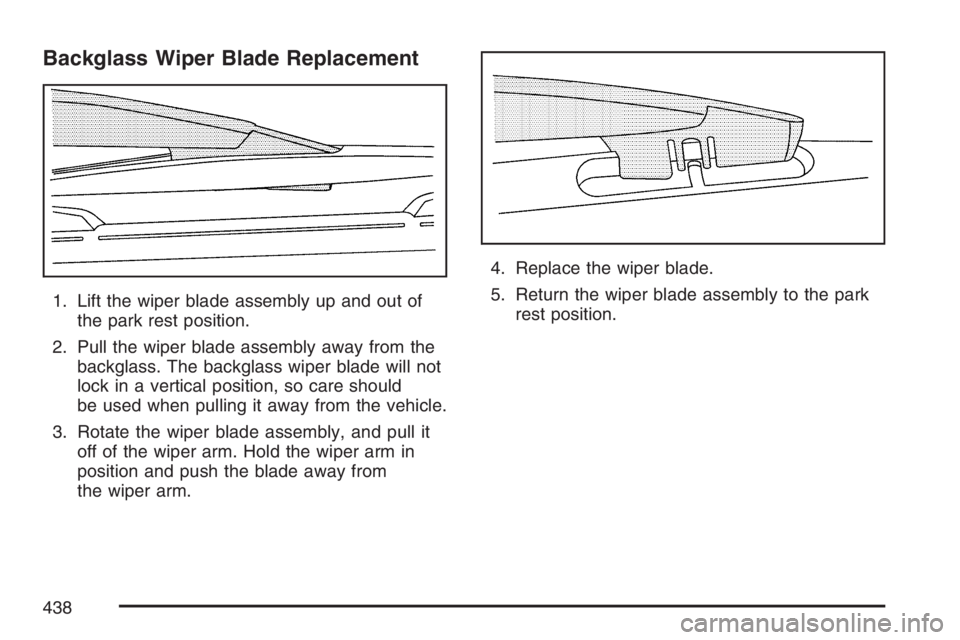
Backglass Wiper Blade Replacement
1. Lift the wiper blade assembly up and out of
the park rest position.
2. Pull the wiper blade assembly away from the
backglass. The backglass wiper blade will not
lock in a vertical position, so care should
be used when pulling it away from the vehicle.
3. Rotate the wiper blade assembly, and pull it
off of the wiper arm. Hold the wiper arm in
position and push the blade away from
the wiper arm.4. Replace the wiper blade.
5. Return the wiper blade assembly to the park
rest position.
438
Page 439 of 562
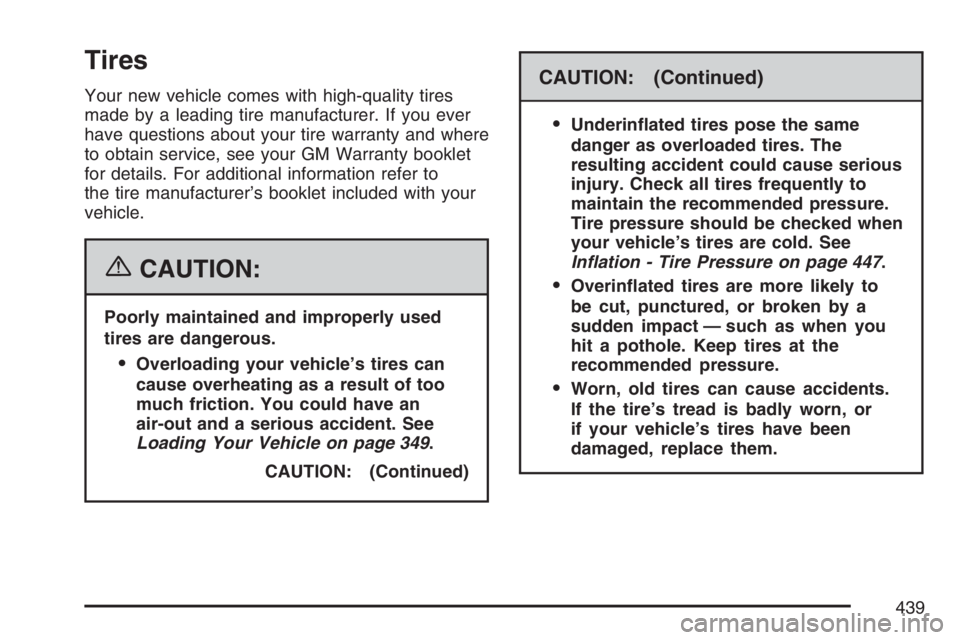
Tires
Your new vehicle comes with high-quality tires
made by a leading tire manufacturer. If you ever
have questions about your tire warranty and where
to obtain service, see your GM Warranty booklet
for details. For additional information refer to
the tire manufacturer’s booklet included with your
vehicle.
{CAUTION:
Poorly maintained and improperly used
tires are dangerous.
Overloading your vehicle’s tires can
cause overheating as a result of too
much friction. You could have an
air-out and a serious accident. See
Loading Your Vehicle on page 349.
CAUTION: (Continued)
CAUTION: (Continued)
Underin�ated tires pose the same
danger as overloaded tires. The
resulting accident could cause serious
injury. Check all tires frequently to
maintain the recommended pressure.
Tire pressure should be checked when
your vehicle’s tires are cold. See
Inflation - Tire Pressure on page 447.
Overin�ated tires are more likely to
be cut, punctured, or broken by a
sudden impact — such as when you
hit a pothole. Keep tires at the
recommended pressure.
Worn, old tires can cause accidents.
If the tire’s tread is badly worn, or
if your vehicle’s tires have been
damaged, replace them.
439
Page 440 of 562
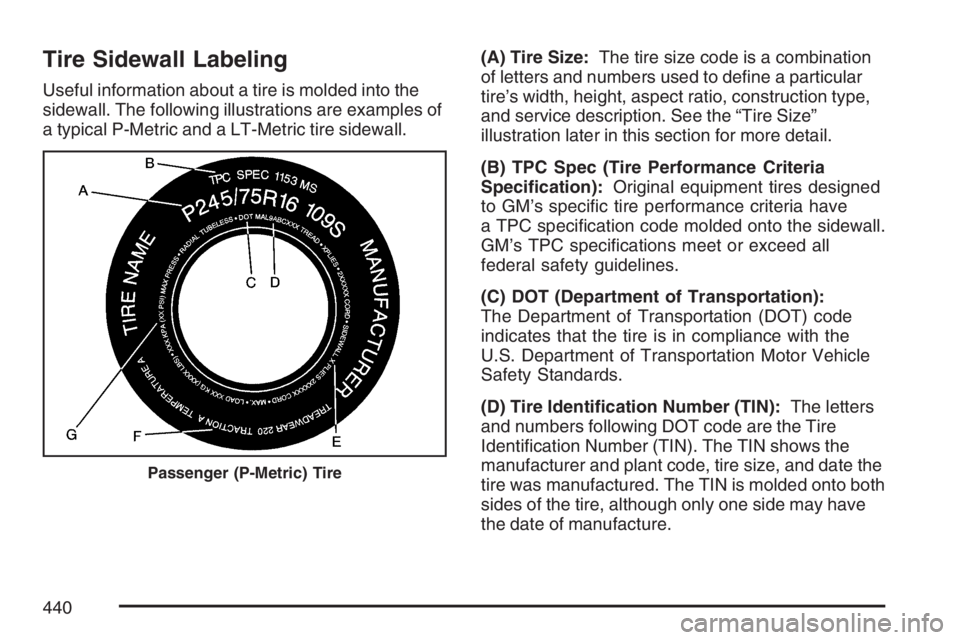
Tire Sidewall Labeling
Useful information about a tire is molded into the
sidewall. The following illustrations are examples of
a typical P-Metric and a LT-Metric tire sidewall.(A) Tire Size:The tire size code is a combination
of letters and numbers used to de�ne a particular
tire’s width, height, aspect ratio, construction type,
and service description. See the “Tire Size”
illustration later in this section for more detail.
(B) TPC Spec (Tire Performance Criteria
Speci�cation):Original equipment tires designed
to GM’s speci�c tire performance criteria have
a TPC speci�cation code molded onto the sidewall.
GM’s TPC speci�cations meet or exceed all
federal safety guidelines.
(C) DOT (Department of Transportation):
The Department of Transportation (DOT) code
indicates that the tire is in compliance with the
U.S. Department of Transportation Motor Vehicle
Safety Standards.
(D) Tire Identi�cation Number (TIN):The letters
and numbers following DOT code are the Tire
Identi�cation Number (TIN). The TIN shows the
manufacturer and plant code, tire size, and date the
tire was manufactured. The TIN is molded onto both
sides of the tire, although only one side may have
the date of manufacture.
Passenger (P-Metric) Tire
440